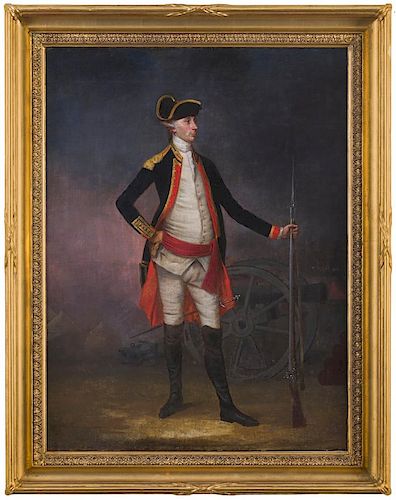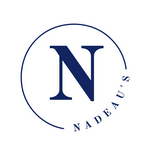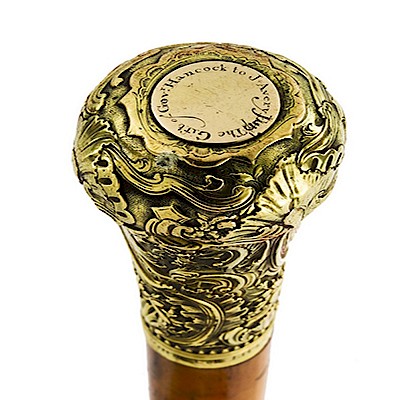A NEWLY DISCOVERED WILLIAM WILLIAMS PORTRAIT OF A COLONIAL AMERICAN OFFICER WILLIAM WILLIAMS (1727-1791) Portrait of a New York o...
Two ways to bid:
- Leave a max absentee bid and the platform will bid on your behalf up to your maximum bid during the live auction.
- Bid live during the auction and your bids will be submitted real-time to the auctioneer.
Bid Increments
| Price | Bid Increment |
|---|---|
| $0 | $25 |
| $300 | $50 |
| $600 | $100 |
| $2,000 | $250 |
| $5,000 | $500 |
| $10,000 | $1,000 |
| $30,000 | $2,500 |
| $70,000 | $5,000 |
| $100,000 | $10,000 |
| $1,000,000 | $25,000 |
About Auction
Oct 19, 2019
Inaugural Sale of the Mars and Neptune Trust Nadeau's Auction Gallery info@nadeausauction.com
- Lot Description
A NEWLY DISCOVERED WILLIAM WILLIAMS PORTRAIT OF A COLONIAL AMERICAN OFFICER WILLIAM WILLIAMS (1727-1791) Portrait of a New York or Pennsylvania Artillery Officer, 1772 Oil on canvas, 30 x 25 inches, signed and dated lower: 'Wm. Will[iams] / 1772'; in later carved and gilded frame One of only two known portraits by William Williams of colonial American soldiers, this painting was hiding in plain sight in an exhibition gallery of the Fort Ligonier Museum for the past 45 years. It had been donated to the museum as an Allan Ramsay portrait of Arthur St. Clair, executed prior to his departure from Scotland to America as a young subaltern in the 60th Foot or Royal Americans, with even a spurious version of the artist's and sitter's names painted to the upper right background of the portrait—something often found in actual Ramsay portraits from the 1750s. The portrait as then identified would have been an invaluable addition to the collection, as Scottish-born St. Clair had served at the post during the French & Indian War and later lived in Ligonier, Pennsylvania (both prior to, and following his public service as major general in the Continental Army and again, after his term as the first governor of the Northwest Territory). However, over the years, the identity of the sitter, artist attribution and details of the uniform have all come into question. In 2007, this cataloger sent a 3-page letter to the then-director of Fort Ligonier documenting the dress to be that of a Royal Artillery officer (a corps in which St. Clair never served) and also to a postwar window of 1768-1770, based on specific details of the uniform and equipage depicted. Falling outside the museum's scope of collections, the portrait was eventually deaccessioned and consigned to this sale. Permission was granted by Fort Ligonier to have conservation work done on the portrait prior to the sale, including the removal of the spurious identification painted on the canvas. During the cleaning and removal of old inpainting, the remains of the original signature and date were discovered "bottom left, wrought in a fine, detailed hand, [that had] been worn away probably by the inevitable attempts to make it more legible by saliva coated fingers" (Mosorjak 2019). Later examination determined it to be 'Wm. Will[iams] / 1772" and comparison of it with signatures from other known Williams paintings of the 1760s-1770s, as well as painting technique and composition, confirmed the cataloger's initial reaction that this was indeed a work by the hand of William Williams. William Williams is perhaps best-known today as Benjamin's West's original instructor in drawing and painting, as well as being the author of the anonymously and posthumously published, but semi-autobiographical novel, The Journal of Llewellyn Penrose, a Seaman (1815). He was born in Bristol, England and has been said to have been self-taught as a painter, but study of this and documented paintings by Williams suggest that he also benefited from professional instruction. As noted by conservator Michael Mosorjak in his condition report on the painting: "The prepared canvas was underpainted in a traditional, academic technique…utilized for centuries in western Europe…consisting of a mixture of a black (lamp or bone), a white lead (oxide), a red (ferrous oxide) and a yellow (ferrous – either yellow ochre or raw sienna), and termed 'verdaccio'. The design layer ('abbozzo) is applied atop and colors are laid, glazed, or scumbled in. The underpainting is often left and incorporated into the design layer to serve as middle to high dark values and shadows. This technique indicated that the artist had some or extensive formal training or instruction, probably in the studio of another artist, and his applications are closely associated with British painting of the 18th century." Williams was clearly an "artist of talent and facility", as noted by art historian Edgar P. Richardson, receiving payment of 100 pounds for at least one work—no small sum in that period. Ellen Miles (1987) notes of the delicate coloring employed in his works, the middle ground placement of the subject, and the stagelike settings of his backgrounds, no doubt influenced by his past work as a scenery painter for theatrical productions. Williams worked in Philadelphia from 1747 until c. 1769 (incl. a 3-year hiatus to the West Indies, 1760-1763), after which he relocated to New York City in search of new commissions, working primarily in that city until 1776, when he returned to England. Most of the surviving American portraits by Williams are full-length, whether painted in larger or smaller format. A portrait from his New York period that appears closely related to this work is a smaller oil (23 1/2 x 17 1/8 in.) of "Private McKinney", signed and dated 1773 (formerly in the Warner Collection, Tuscaloosa, AL). Both subjects are citizen-soldiers, McKinney a member of the elite New York Grenadiers, a volunteer company formed in c. 1765 and our subject dressed in a uniform based on that of the Royal Artillery. At least two colonial units are known to have modeled themselves on the Royal Artillery: Samuel Tudor's "first Royal Artillery Independent Company" of New York City and Benjamin Loxley's Artillery Company of the Philadelphia Associators (expanded to four companies by 1776, one of which—Moulder's) can be seen wearing a near-identical uniform in the foreground of James Peale's painting, The Battle of Princeton). However, unless Williams did occasionally return to Philadelphia after moving to New York, the most likely candidate is Tudor's New York Company, described wearing blue coats, faced red and white smallclothes. Our officer holds a fusil (abolished for Royal Artillery officers in 1770), and has the badges of rank of an officer, including epaulette, sash and sword. The artillery piece that he stands before is one with an iron barrel—those used by the British Royal Artillery were of bronze. The company's four officers: CPT Samuel Tudor, CPT-LT James Seagrove, and LTs Nicholas Bogert and Francis Lewis, Jr. were all from well-to-do New York society families and certainly able to afford not only their military kit, but also a possible portrait by Williams. Property of the Fort Ligonier Association.All lots are sold "AS IS" The condition of lots can vary widely and are unlikely to be in a perfect condition. *No credit card payments will be accepted for silver, gold, or jewelry from buyers that have not purchased from our gallery in the past.
Condition
- Shipping Info
-
SHIPPING While we do not pack or ship any items, we have provided the list of shippers below as a courtesy. Please understand, you may use any shipper or third party you choose and that Nadeau’s Auction Gallery takes no responsibility for any acts or omissions of any of the vendors on this list. Buyers assume full responsibility for the packing and shipping of lots won at auction. We have provided a list of our Shippers to assist you. If a buyer has a purchase shipped out of state via a licensed shipper (shipper must have a Motor Carrier number) and shipper must provide an official Bill of Lading, sales tax will be not be assessed. All shippers on our website are licensed shippers. ***Please note: if you choose to use a shipper that is not on our recommended list, be sure that they have an MC# (Motor Carrier Number). If they do not have an MC#, your account will be charged Connecticut sales tax. We require written authorization from the buyer to release any property to anyone other than the buyer. You can send the Shipping Release Form via fax to 860-524-8735 or email to info@nadeausauction.com. When arranging for a shipper, please be aware that all items should be picked up within one week of the auction unless arrangements have been made in advance with our office. Please confirm that they will be able to meet our deadline for pick-up. If your shipper isn’t able to pick-up within our allotted time frame, storage charges will accrue. SMALL PACKAGES Company Phone Email The UPS Store 860-643-6264 store0921@theupsstore.com We Pack 860-803-3935 wepackship@snet.net LOCAL AND TRI-STATE DELIVERY Company Phone Email Nadeau’s Auction 860-246-2444 info@nadeausauction.com LARGE FURNITURE Company Phone Email Vintage Trucking 413-212-1252 vintagetrucking@aol.com Plycon Transportation Group 631-269-7000 kingspark@plycongroup.com Transport Consultants Int. 800-752-7002 Brie@shippingmadesimple.com Ace Exchange 646-546-1075 ace1exchange@gmail.com Sure Express Worldwide 877-877-0889 info@sureexpress.com HIGH VALUE FINE ART Company Phone Email Artex 866-407-9660 artexma@artexfas.com North South Art Transfer 978-491-9353 scottcousins22@aol.com U.S. Art 800-472-5784 JPierce@usart.com AirSea 718-937-6800 aspny@airseapacking.com Please notify us when your arrangements have been made. If you are the successful bidder you can notify your shipper, be sure to let them know that they will need to package the items themselves. Provide your shipper with your first and last name and either the lot numbers you purchased or your invoice number (located at the top right hand corner of your invoice).
-
- Buyer's Premium



 EUR
EUR CAD
CAD AUD
AUD GBP
GBP MXN
MXN HKD
HKD CNY
CNY MYR
MYR SEK
SEK SGD
SGD CHF
CHF THB
THB












